Key takeaways:
- A crypto exchange is a digital platform for buying, selling, and trading cryptocurrencies, with evolving features like staking and lending.
- There are three main types of exchanges: centralized exchanges (e.g., Coinbase), decentralized exchanges (e.g., Uniswap), and hybrid exchanges that combine both approaches.
- Current trends include increasing regulatory compliance, advanced trading tools, and improved user experience to attract novice traders.
- For safe trading, users should enable two-factor authentication, start with small investments, and be aware of fees associated with trades.
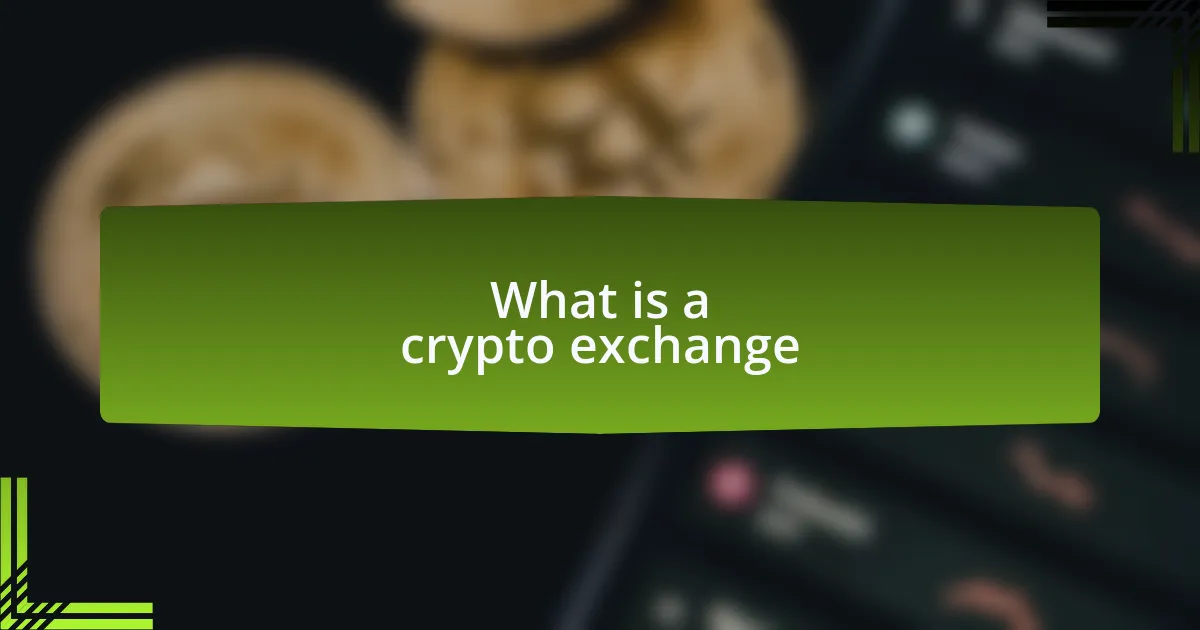
What is a crypto exchange
A crypto exchange is a digital marketplace where individuals can buy, sell, or trade cryptocurrencies like Bitcoin, Ethereum, and many others. It’s fascinating how these platforms have transformed the way we view and handle money. I remember the first time I used a crypto exchange; it felt like stepping into a new financial universe. Have you ever thought about how different it is from traditional banks?
These exchanges not only facilitate transactions but also provide access to various digital assets. Using these platforms can feel overwhelming at first, given the plethora of options and functionalities. I still recall my initial confusion trying to navigate the different features, charts, and market trends. It makes me appreciate how user-friendly some exchanges have become as they evolve to meet the needs of both novices and seasoned traders.
Moreover, many exchanges now offer advanced features like staking, lending, and derivatives trading. I find it exciting to see how these platforms are not just about trading anymore; they’re evolving into comprehensive financial ecosystems. Have you explored these features yet? They can greatly enhance your crypto experience and may even provide additional income streams if used wisely.
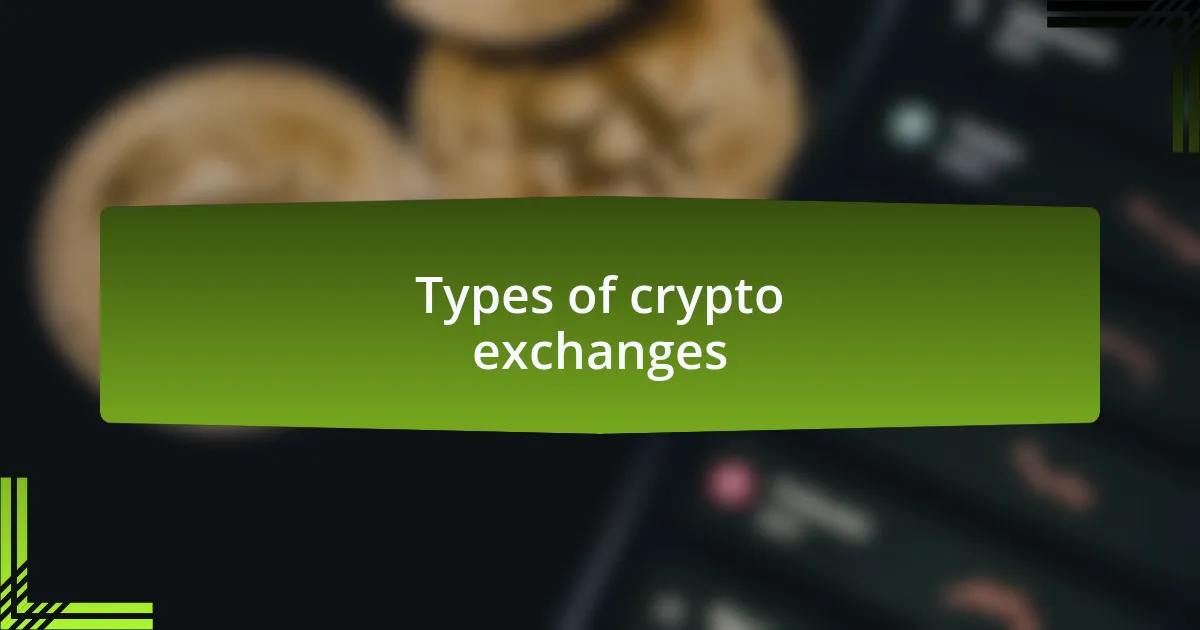
Types of crypto exchanges
When it comes to crypto exchanges, I think it’s important to understand the main types available — centralized and decentralized exchanges. Centralized exchanges, like Coinbase or Binance, act as intermediaries between buyers and sellers. I remember using Binance for the first time, feeling a blend of excitement and skepticism as I entrusted my funds to a third party. It’s amazing how they can simplify transactions, but does this ambivalence about control resonate with you too?
On the other hand, decentralized exchanges (DEXs) like Uniswap allow for peer-to-peer trading without a central entity. I’ve had some eye-opening experiences using DEXs; the lack of a middleman means greater privacy and control over my assets. Yet, I often find myself asking—are the benefits worth the potential risks of navigating these platforms without additional safeguards?
Additionally, hybrid exchanges are emerging, combining the best of both worlds. They aim to provide the user-friendly experience of centralized exchanges while maintaining the autonomy of decentralized platforms. It’s intriguing to see how these innovations are shaping the future of trading. Have you tried a hybrid exchange yet? It might just change your perspective on how you engage with the crypto market.
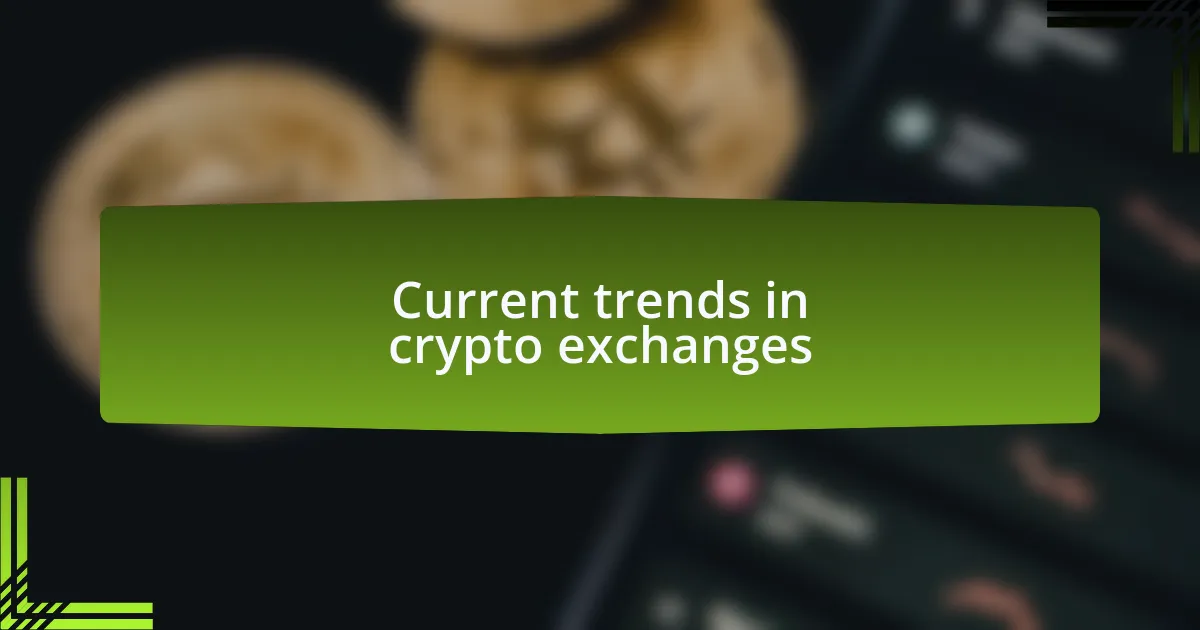
Current trends in crypto exchanges
One current trend that stands out in the crypto exchange landscape is the rise of regulatory compliance. As governments worldwide implement stricter regulations, exchanges are adapting their practices to align with legal standards. I vividly recall the days when many platforms operated in a gray area, and it felt like the wild west of finance. Now, I find it reassuring that many exchanges are prioritizing compliance, as it adds a layer of trust for users like myself, but it does raise questions about privacy and freedom in trading.
Another evolving trend is the integration of advanced trading features, such as automated trading bots and sophisticated analytic tools. Personally, I started utilizing trading bots recently, and it’s fascinating how they can execute strategies I wouldn’t have the time or expertise to manage manually. These tools can be incredibly useful, but I often wonder—are we placing too much faith in algorithms over human intuition and experience?
Lastly, I’ve noticed a growing emphasis on user experience across all types of exchanges. Enhanced interfaces and educational resources are becoming a priority as exchanges aim to attract new traders. Reflecting on my own journey, I’ve experienced the frustration of navigating complex platforms that seemed designed for seasoned traders. I appreciate when exchanges make a concerted effort to simplify their interfaces—after all, a smoother experience can foster greater involvement in the crypto community. What features do you think are essential for making trading more accessible?
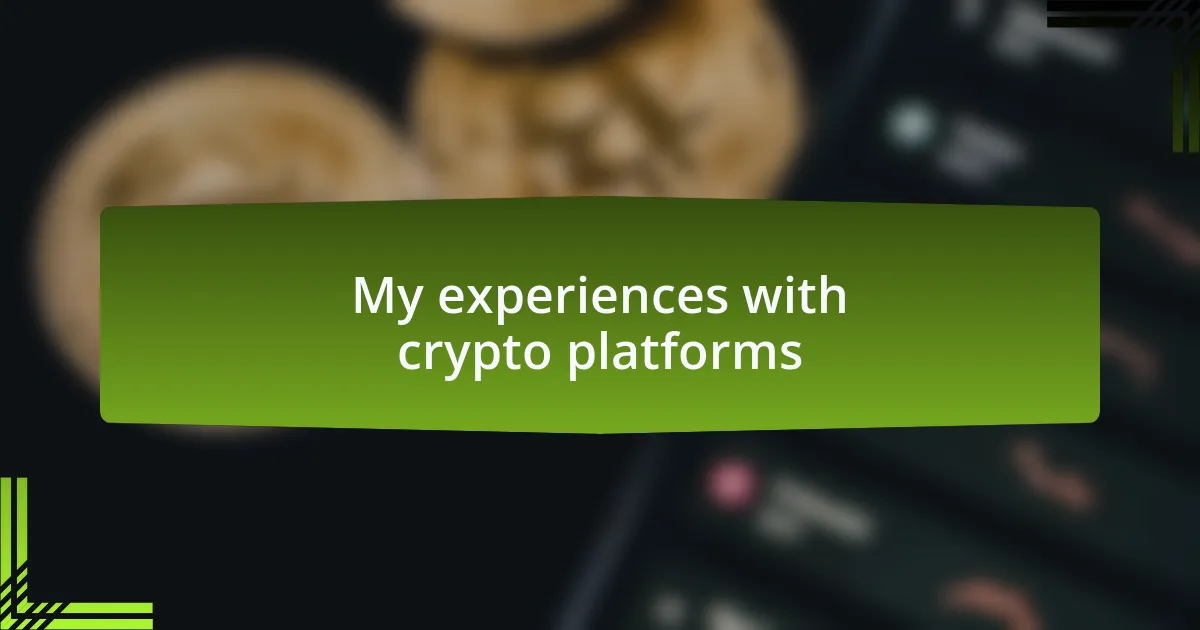
My experiences with crypto platforms
Reflecting on my experiences with crypto platforms, I can’t help but recall the initial learning curve I faced. When I first ventured into this space, I was overwhelmed by the vast array of options and features. I remember spending hours trying to understand different wallets and order types, often feeling lost. This made me appreciate platforms with strong customer support, as having someone to guide you through those early challenges can make all the difference.
As I explored various exchanges, I came to value the sense of community they fostered. Participating in forums and discussion groups led to incredibly enriching conversations that shaped my understanding of the market. It’s fascinating how sharing insights with fellow traders can provide different perspectives, often highlighting nuances I hadn’t considered before. Have you ever had a conversation that completely changed your approach to trading?
I’ve also found that my preferences for trading platforms have evolved alongside my trading style. Initially, I was drawn to the most popular exchanges, but as I gained experience, I started seeking out platforms that offer unique features tailored to specific needs, like lower fees or unique asset offerings. It’s interesting to think about how our personal strategies influence our choice of tools in this rapidly changing landscape. What aspects of a platform do you prioritize as your trading journey progresses?
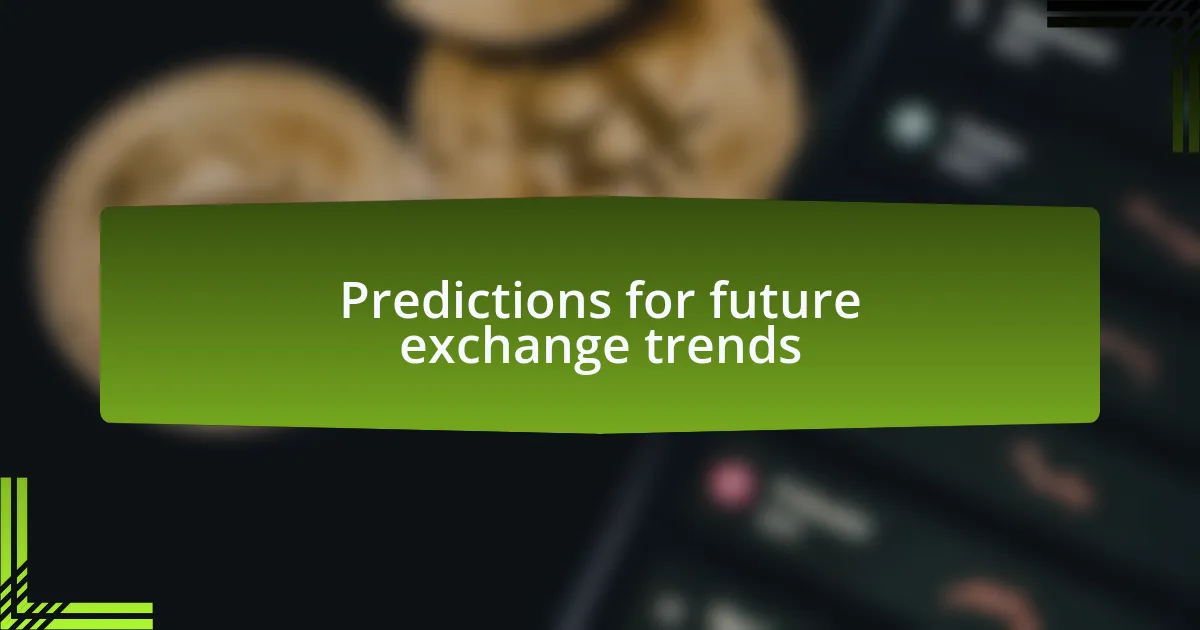
Predictions for future exchange trends
As I look toward the future, I predict that regulatory clarity will play a crucial role in shaping exchange trends. When I first entered the market, the uncertainty around regulations often felt daunting. However, as governments become more proactive in establishing frameworks, I believe exchanges will adapt by offering more transparent services that enhance user trust. Have you noticed how much more comfortable traders seem in a regulated environment?
Additionally, I foresee a significant rise in decentralized exchanges (DEXs). My experiences with liquidity challenges on traditional platforms led me to explore DEXs, where I found a sense of autonomy and flexibility that was refreshing. As more users embrace this model, we could see DEXs gaining market share, driven by their promise of security and reduced reliance on centralized entities. Isn’t it exciting to think about a future where traders have more control over their assets?
Finally, I anticipate the integration of advanced technologies like AI and machine learning in exchange platforms. During my own trading journey, I’ve seen a growing reliance on data analytics to make informed decisions. I believe that as these technologies evolve, exchanges will offer features like predictive trading tools that empower users to navigate complex markets with greater confidence. How would having such advanced tools at your fingertips change your trading strategy?
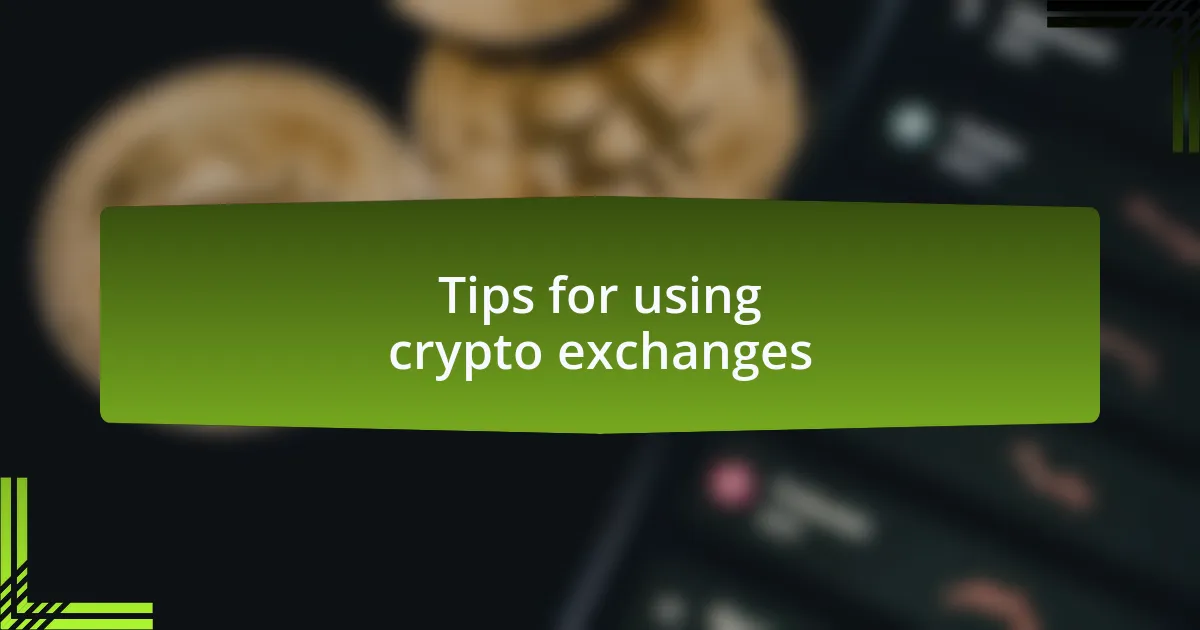
Tips for using crypto exchanges
When using crypto exchanges, it’s essential to prioritize security by enabling two-factor authentication (2FA). I remember the moment I experienced my first tip-off about potential hacks online; it was alarming. Implementing 2FA not only adds a layer of protection but also gives me peace of mind when trading. Why take the risk?
I also suggest starting with small investments and gradually increasing your commitment as you become familiar with the platform. In my early days, I put too much into trades too soon, only to feel the heart-pounding anxiety when the market turned. By taking the time to understand the exchange dynamics, you’ll build confidence and make more informed decisions without the stress that comes from diving in headfirst.
Lastly, always keep an eye on the fees associated with trades and withdrawals. I’ll never forget the surprise I had when I realized that a hefty percentage went to fees after a lucrative trade. Taking the time to read the fee structure can save you significant money in the long run. Does that sound like a frustrating experience? It was for me, and I learned my lesson the hard way.